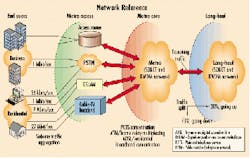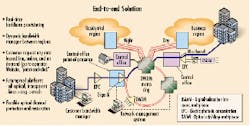IP-centric networking will require new capabilities that new optical switch routers will provide.
Jin-Yi Pan and Baksheesh Ghuman
Sorrento Networks
The exploding growth of data traffic and increasing demand for greater network efficiencies are having a significant effect on dense wavelength-division multiplexing (DWDM) system development. In the metropolitan area, adopting an Internet-protocol (IP)-centric intelligent optical-network model represents the next generation of metro optical networks. This model-referred to as the proactive metropolitan optical network (PMON)-not only offers service providers a viable solution to many of today's key challenges, but can also deliver a number of distinct competitive advantages.
The primary goal of the PMON is to proactively provide an end-to-end metro optical-networking solution through access, transport, switching, and management (see Figure 1). This solution is possible because of a critical element-a wavelength switch router, which enables carriers to meet the expectations for tomorrow's all-optical infrastructure. Along with a metro DWDM device that aggregates traffic from the backbone, the subrate multiplexer, which takes lower bit rate signals and combines them into one wavelength, a metro DWDM solution is achieved that allows for a fully utilized wavelength.
The wavelength switch router is a dynamic add/drop that has automatic connection management capability. The terminal has the intelligence to set up connections automatically through user dial-up, operator dial-up, or packet-based routing. Just as the connection setup or teardown is much faster than traditional methods-typically less than 1 sec-the network can be used as efficiently as the telephone network where the user makes the connection.Figure 1. A metro network provides the transition from the long-haul network to the end users. It contains both the metro-core and the metro-access infrastructure.
In existing Synchronous Optical Network (SONET) and DWDM systems, the network-management system performs point-and-click connection management. Connections are usually either permanent or semi-permanent. Much of today's network architecture was designed when voice was the predominant service and the network could be pre-planned based on reasonably predictable traffic patterns and growth. However, data traffic has characteristics that are very different from voice traffic, such as a high access rate, multiple services, and a dynamic traffic pattern. Consequently, network requirements are changing, and these changes are driving deployment of new network architectures and approaches such as the PMON.
Figure 2. While current networks frequently use point-to-point or ring architectures (or a combination of the two), an evolution toward a mesh topology will provide more efficient use of network resources.
The emergence of the PMON as a viable next-generation solution for service providers can be attributed to a number of business drivers, including:
- Mesh network. The existing transport network architecture is mainly point-to-point or a ring-based network (see Figure 2). In a network-failure condition, the protection path is preconfigured, and operation is simple. Recently, there has been an increasing interest and focus by carriers and vendors on the properties, applications, and value of mesh networks. The primary motivating factors behind this shift are the network cost savings obtained from increased bandwidth efficiency and increased networking flexibility when compared to ring-based networks. Although the mesh topology is an excellent framework for the PMON architecture, it is by no means critical. However, the mesh framework is ideal for leveraging current optical and IP technologies to meet customer requirements.
- Transparency. The demand for data services on the network is increasing the variety of native client signals that must be transported by the network. The variety of client signals is typically more significant in the metropolitan environment than in the long-haul network, since long-haul traffic needs to be converted into a particular signal format (such as SONET) before the transmission. One solution for accommodating an emerging service is to develop new interfaces for each new service, resulting in significant development, equipment, and inventory costs. It may also impede the operator's responsiveness to support new services, otherwise referred to as "provisioning." With optical transparency, a generic interface can be used to accommodate all services, enabling providers to offer services without regard to customer traffic type. Optical transparency also extends to any baseband digital signal and analog signal (e.g., QAM-like RF signal in cable-TV applications).
- Real-time provisioning. Real-time provisioning is a vital capability in meeting new and existing customer needs. In an environment where a wide range of technologies is deployed at the customer premises, demand is high for data services and fast network access. Real-time provisioning capabilities enable service providers to respond to customer requests quickly. In today's fast-paced business environment, the quickest response often wins the order.
- Intelligent IP network. Much of the existing transport network was built when voice was the predominant service. Given the stability of backbone traffic, the connection in the backbone network is usually permanent or semi-permanent. The bandwidth management is based on semi-automatic provisioning, which requires coordination between the management system of the crossconnect, network elements, and human interaction. Service flexibility is typically provided through connection setup operations performed by voice switches.
The spectacular growth of Internet traffic is changing the characteristics of transport network traffic. In the emerging info-centric network, provisioning bandwidth becomes very difficult and inefficient because data traffic is dynamic and "bursty" in nature. Depending on the time of the day, traffic may also swing between serving regions.
As a result, it is very difficult to provision bandwidth, as traffic patterns become unpredictable. What's more, it becomes necessary to re spond to traffic congestion "on the fly" in order to use network resources efficiently. To cope with these de mands effectively, logic dictates that the next-generation metropolitan optical transport network becomes data (IP) centric (see Figure 3).Figure 3. Intelligent routing can improve both reliability and network efficiency. The provisioning of services becomes much easier and quicker using intelligent IP routing.
Experts agree that a proactive network that includes automation of the transport network is crucial for ensuring optimal usage of network resources. As such, a design must move away from quasi-static, slow-response connection control implemented via network-management protocols toward fast response, rapid churn, and shorter holding times. The result is improved network utilization while simultaneously decreasing signal latency.
These business drivers-which are also the four cornerstones of the PMON-provide network operators with a number of distinct competitive advantages:
- Transparency. With a standardized transparent protocol, the PMON delivers considerable cost savings. By leveraging crossconnects, pro viders can reduce the amount of equipment in their network and therefore reduce costs. Another competitive advantage derived from transparency is improved network-management capabilities. By removing many intermediate layers, network management becomes simpler, more proactive, and more dynamic. With its ability to provide cost savings, the PMON enables service providers to deliver services at the most competitive price.
- Real-time service provisioning. By reducing the provisioning interval, network operators can deliver services to market faster-a major advantage in competitive markets. What's more, the faster services can be turned up, then the faster providers can start charging for them. Real-time service provisioning also provides a highly effective method of using bandwidth, which can be switched depending on current traffic patterns.
- Intelligent IP routing. The optical switch router provides IP intelligence at the optical layer whether the topology is mesh or ring. In fact, it can provide mesh topologies with a level of reliability typically associated with SONET. In addition to the benefits derived from a transparent network, IP intelligence can be used to control and manage the network effectively. For example, providers can recover automatically as bandwidth over the network can be automatically rerouted if necessary. Typically, a technician would have to be dispatched and many manual procedures may be required. With IP functionality within the optical layer, all nodes can be monitored and updated in real time. With more granular and accurate information available instantly, intelligent IP routing capabilities can be used much like an automatic network-planning tool. As a result, available capacity can be better used. This optimization enables providers to put more services on their network while still meeting quality-of-service objectives and service-level agreements.
- Mesh topologies. Due to their inherent flexibility, mesh networks are far easier to plan and upgrade. This "pay-as-you-grow" capability enables bandwidth and equipment to be added when and where customers are added. What's more, with mesh topologies, service providers receive revenue from an initial low-cost investment as soon as the first customer is activated. This approach is in stark contrast to the majority of network solutions that essentially require the entire network to be planned, built, and paid for before the first potential customer is even contacted. Mesh networks also provide a scalable migration path from ring to hybrid to mesh and potentially fast, efficient restoration. Together, mesh topologies and the PMON provide a fiber-efficient, futureproof network topology that can accommodate real-time provisioning.
Figure 4. The metro network of tomorrow will see dynamic configuration management from one end of the network to the other. Optical switch routers will prove to be the lynch pin of these networks.
The end-to-end metro optical network of the future-with the optical switch router as the lynch pin-provides a proactive solution that is transparent, intelligent, efficient, scalable, dynamic, manageable, and capable of supporting a mesh topology to improve network utilization. Adoption by service providers will yield many significant and tangible competitive advantages that will lay the foundation for continued business success.
Jin-Yi Pan is vice president of system architecture and Baksheesh Ghuman is vice president of marketing at Sorrento Networks (San Diego, CA).



